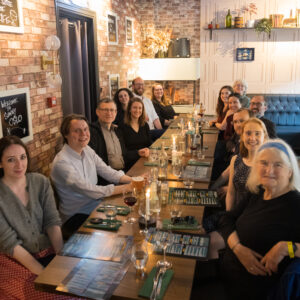It’s that time of year again – the month of CEMLM’s annual meeting! This year we met in Oslo, where Prof Ildar Garipzanov’s project on MINiTEXTS graciously hosted us with a workshop on “Minuscule Texts and Cultures of Healing in the Early Middle Ages.”

Claire launched the workshop with a complex investigation of MRCs (mini recipe collections) and new ways of thinking about their plasticity as well as their stability across different manuscripts. Jeff followed this with a fascinating discussion of medical writings found on flyleaves. Carine offered an entirely new methodology for cataloguing and comparing early medieval variations on bloodletting and illness lunaries (you can look forward to brightly coloured chequered boxes!). Meg analyzed short monthly regimen instructions and compared these to Internet ads for simple health hacks. Finally, James provided an extensive examination of one of the most prolific (yet seriously under-studied) early medieval medical texts – this being the famous Letter from Hippocrates to King Antiochus. We’re only reporting on the research of CEMLM members, for obvious reasons of privacy, but let us just note that all of the above were interspersed with papers assessing minuscule texts in the context of classical transmission, extant Coptic material, texts on wine, and both Old English and Old Irish writings. The two days of the workshop made for provocative and inspiring connections between the Latin material and other early medieval regions.


Following the MINiTEXTS workshop, the five of us were hard at work on finalizing the Handlist (expect big things soon!), planning future critical editions and co-authored books, and thinking about how to introduce early Latin medicine to a wider public. The group has many different projects underway, and some of these should start to come to fruition in the coming year. In addition to the Handlist, there is an edition of the entire Rotulus von Mülinen (featured in our MOTM 11 blog), with its hundreds of medical recipes, that is close to completion. And though still in its early stages, an edition and translation of various pseudo-Hippocratic medical letters is also something that group has set in its sight. Finally, during our meeting in Oslo, the team began writing chapters of a “minigraph” (a short, introductory monograph) that reimagines the scope and mindset of medical knowledge and healing practice in the early Latin West, particularly in light of the expanded corpus of material uncovered through CEMLM’s Handlist. We hope that this work can serve as an overview for those with little background in this period of the history of science and can highlight the entanglement of medicine in everyday life as well as in elite manuscript culture.
We plan to host two CEMLM sessions at the Leeds IMC in 2026 so hope to connect with others interested in early medieval medicine there!